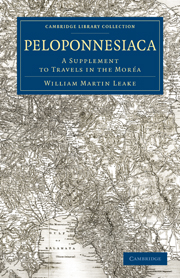Summary
The following pages contain a series of questions of ancient history and geography, supplemental to “Travels in the Moréa,” which have arisen since the publication of that work, chiefly in consequence of the increased facilities given to the examination of the Peloponnesus by its liberation from the Turkish yoke.
The opportunity afforded by that event was eagerly embraced by the French Government,—under all its forms a liberal promoter of the advancement of science. In the year 1829, a numerous and select Commission of Geography, Natural History, and Archæology, was sent to the Peloponnesus, and there employed during two years, under the dangers and difficulties of an ungenial climate, and a country desolated by the effects of one of the most cruel wars recorded in history. The most important result of these labours has been a map, on a scale of the two hundred thousandth part of a degree of latitude, or twenty-one English inches and three-fifths. That which accompanies the present volume has been reduced from the French map on a scale of something more than a third, but not without some variations, a few of which will find their justification in the occasional strictures on the French map made by M. Bory de St. Vincent, Colonel d'Etat Major, and Head of the Commission of Physical Science.
- Type
- Chapter
- Information
- PeloponnesiacaA Supplement to Travels in the Moréa, pp. v - xPublisher: Cambridge University PressPrint publication year: 2010First published in: 1846

